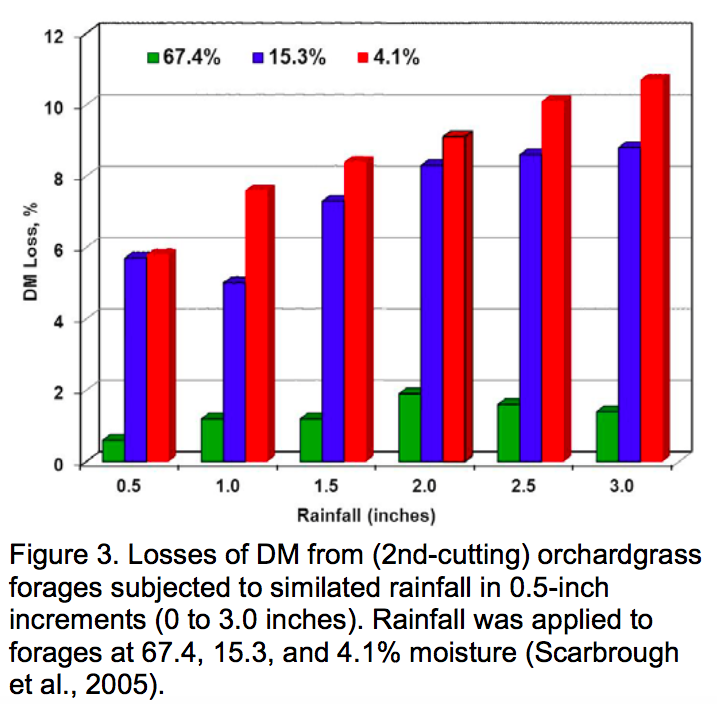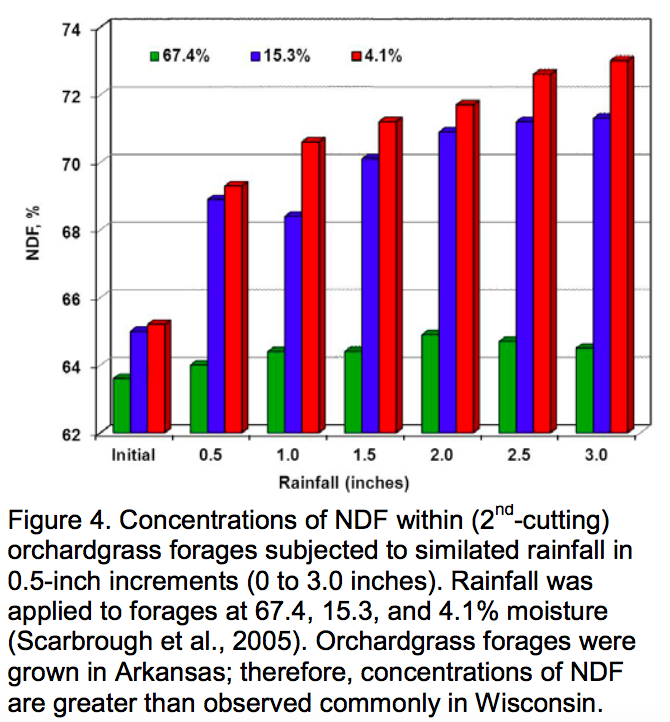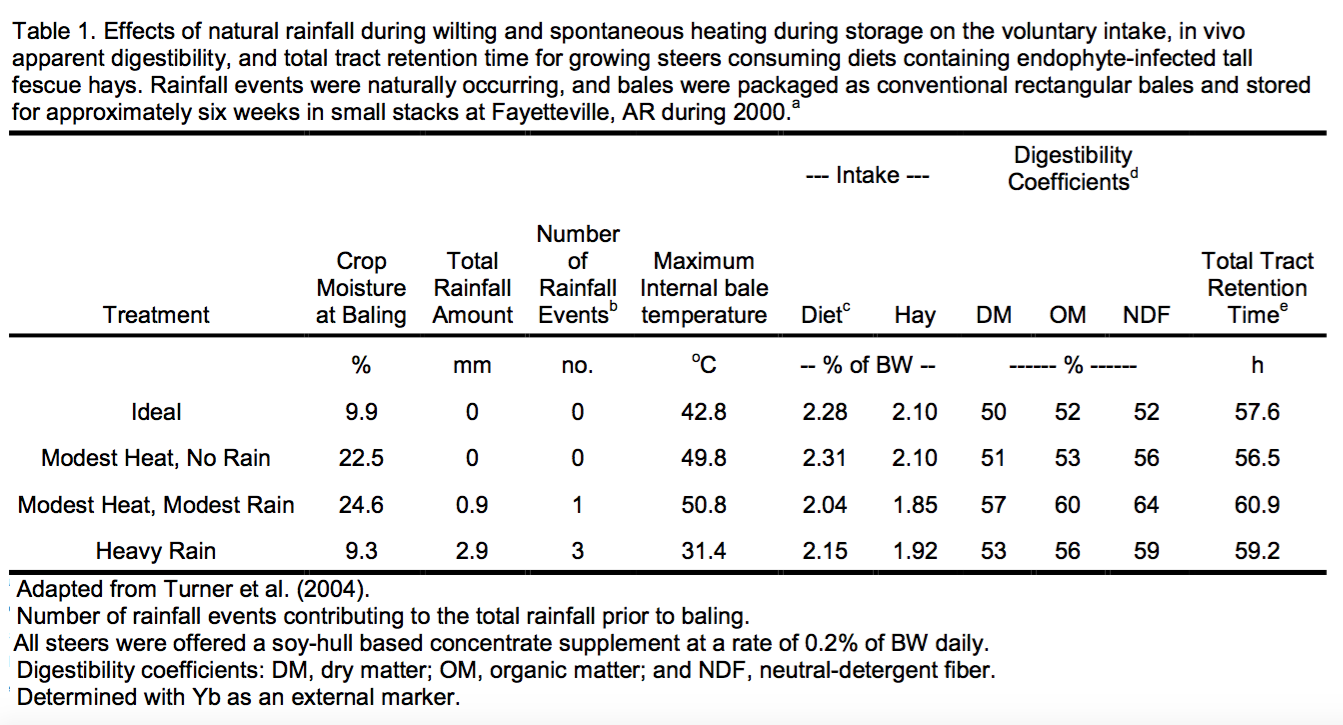Effects of Rain Damage on Wilting Forages
by Wayne K. Coblentz1 and Richard E. Muck2
1US Dairy Forage Research Center, Marshfield, WI
2US Dairy Forage Research Center, Madison, WI
Introduction
One of the most common problems faced by hay or silage producers is how to manage production schedules around unfavorable weather. Inevitably, some wilting forage crops are damaged by rainfall each year, and producers often inquire about the effects of rain damage, and what impact this may have on forage quality, silage fermentation, and animal performance. Actually, the problem is more complex than damage to wilting forage crops via leaching, extended or reactivated plant respiration, and/or leaf shatter. Common consequences of uncooperative weather also may include:
i) spontaneous heating and/or combustion that occurs when producers try to complete baling operations of incompletely wilted hays prior to an oncoming rainfall event;
ii) poor silage fermentation; and
iii) excessively mature forage that results from delaying haying or silage harvesting operations until weather is more favorable. Maturity effects on forage quality can be as severe as spontaneous heating and/or rain damage.
How does plant maturity affect forage quality?
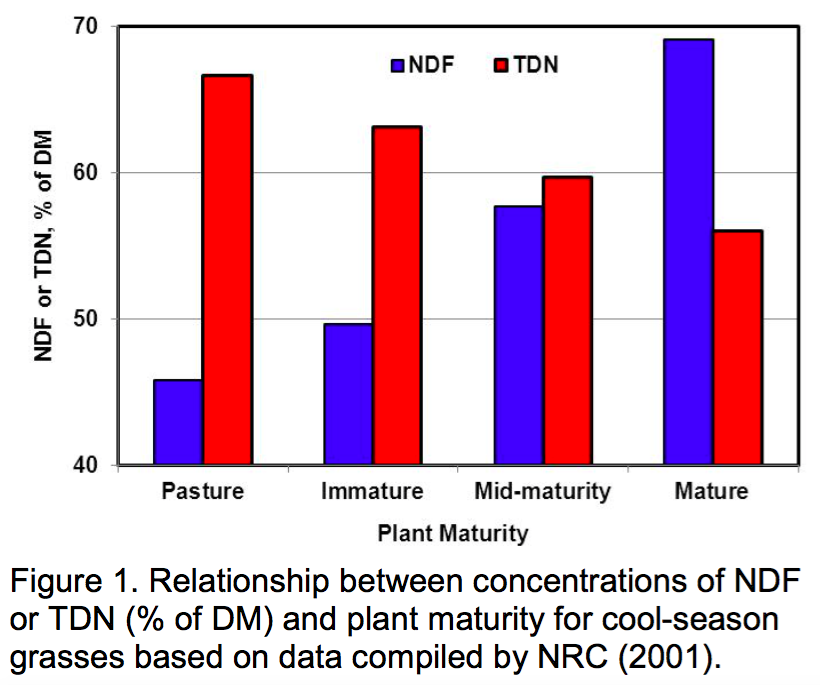 The effects of plant maturity on forage quality are well known to most producers; more than any other factor, the maturity level of the forage at the time of harvest determines the quality of the hay or silage fed to livestock. Generally, ratios of leaf-to-stem decline as forages mature. This results in greater concentrations of fiber components, such as neutral-detergent fiber (NDF), acid-detergent fiber (ADF), and lignin, but reduced concentrations of crude protein (CP), digestible dry matter, and energy (TDN).
The effects of plant maturity on forage quality are well known to most producers; more than any other factor, the maturity level of the forage at the time of harvest determines the quality of the hay or silage fed to livestock. Generally, ratios of leaf-to-stem decline as forages mature. This results in greater concentrations of fiber components, such as neutral-detergent fiber (NDF), acid-detergent fiber (ADF), and lignin, but reduced concentrations of crude protein (CP), digestible dry matter, and energy (TDN). 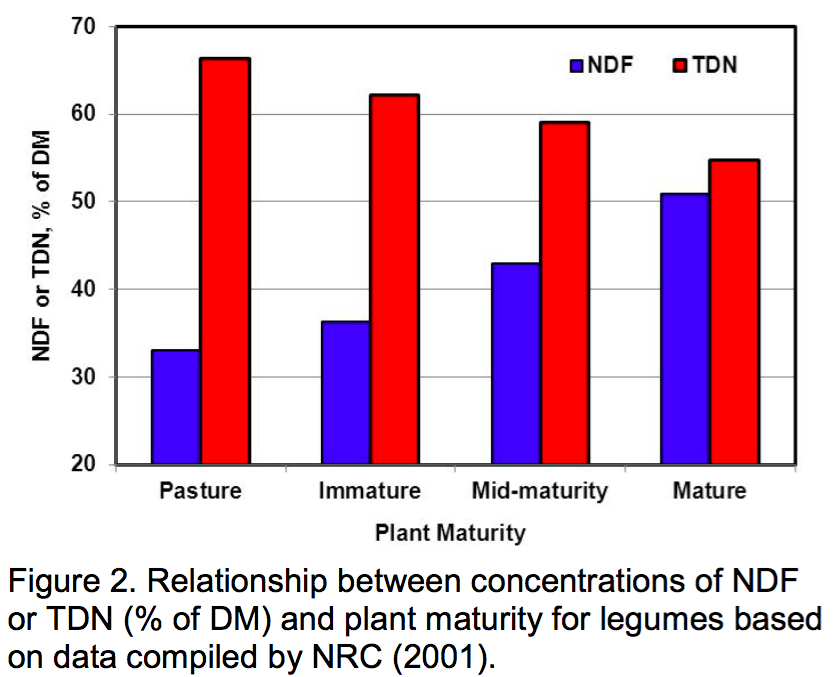 Figure 1 illustrates the inversely related responses for NDF and TDN observed commonly as cool-season grasses mature (NRC, 2001). Similar responses also are observed for legumes (Figure 2). These relationships are important for several reasons. First, increased NDF depresses the energy density of the forage, often necessitating supplementation with concentrates to meet livestock energy requirements. Secondly, greater NDF often reduces intake by livestock consuming forage-based diets. This is especially important when livestock consuming the forage have high nutrient demands, such as lactating dairy or stocker cattle. Finally, and most importantly, these concepts are important because they illustrate that there is always a cost associated with delaying harvest because of potential rainfall events. This cost is forage of lower nutritional value that will not be consumed as readily by livestock.
Figure 1 illustrates the inversely related responses for NDF and TDN observed commonly as cool-season grasses mature (NRC, 2001). Similar responses also are observed for legumes (Figure 2). These relationships are important for several reasons. First, increased NDF depresses the energy density of the forage, often necessitating supplementation with concentrates to meet livestock energy requirements. Secondly, greater NDF often reduces intake by livestock consuming forage-based diets. This is especially important when livestock consuming the forage have high nutrient demands, such as lactating dairy or stocker cattle. Finally, and most importantly, these concepts are important because they illustrate that there is always a cost associated with delaying harvest because of potential rainfall events. This cost is forage of lower nutritional value that will not be consumed as readily by livestock.
What happens when rain falls on wilting forages?
Plant sugars are assumed to be 100% digestible. Therefore, any loss of sugar has a direct effect on the energy density of the harvested forage. During the normal wilting process, respiration of plant sugars continues to occur at moistures suitable for ensiling; numerous research studies have shown that this process slows considerably by the time forages reach 50% moisture, but may persist at a low level until the forage is nearly dry enough to bale as hay. These factors explain why rapid drying to the desired forage moisture concentration is important, regardless of whether the forage is to be preserved as silage or hay. Unfortunately, rainfall events can reactivate respiration within dry forages, and promote the growth of microorganisms on the forage. One study has reported that respiration rates for rain-damaged forages can return to rates similar to those of freshly mown forages (Pizarro and James, 1972) after rewetting by rainfall events. This type of secondary respiration causes additional plant sugars to be respired, greater losses of DM, and further reductions in nutritive value.
Rain falling on wilting forages also directly leaches soluble nutrients (primarily sugars) from the forage. Leaching losses are affected by forage species, the moisture concentration of the forage when the rainfall event occurs, concentrations of soluble sugars within the forage, and the number, amount, intensity, and/or duration of the rainfall event(s). Plant sugars also serve as the primary substrate for formation of lactic acid during the silage fermentation process; therefore, rain-damaged forages can be problematic to ensile. Significant losses of DM also can occur directly as a result of leaf shatter, particularly if the forage is a legume. In addition, any rainfall during the wilting process may lead to additional tedding and raking operations that result in even more leaf shatter before the forage is dry enough to bale.
For cool-season grasses, what percentage of forage DM is lost during rainfall events?
Recently, studies conducted at the University of Arkansas evaluated losses of DM from wilting orchardgrass forages damaged by rainfall delivered from an artificial rainfall simulator (Scarbrough et al., 2005). Simulated rainfall was applied to wilting orchardgrass as a single rainfall event in 0.5-inch increments totaling 0 to 3.0 inches. Orchardgrass forages were wet (67.4%), ideal for baling (15.3%), or excessively dry (4.1%) when rainfall was applied. Losses of DM were minimal (< 2% of DM) if rainfall occurred while the forage was wet, but losses were far greater when the orchardgrass was dry enough to bale (Figure 3), and exceeded 8% of DM when the rainfall amount exceeded 2 inches. These results illustrate several concepts:
- losses of DM generally increase with the amount of rain applied;
- damage to wilting forages usually becomes more severe as forages dry;
- concentrations of NDF increase as sugars are leached from the forage, leaving a more fibrous plant residue with reduced nutritional value (Figure 4).
What other factors influence DM losses following rainfall events?
Work by Rotz et al. (1991) has established that the intensity of rainfall events has a significant effect on the amount of DM lost. Losses of DM were consistently increased when identical amounts of water were applied over longer periods of time. For example, when 0.7 inches of simulated rainfall were applied to alfalfa mowed into heavy swaths, losses of DM were 5.5, 7.8, and 12.1% of total DM when the duration of the rainfall was extended from 1.0 to 3.5 to 7.0 hours, respectively. This may occur because alfalfa retains more water when the rainfall is less intense, thereby facilitating increased leaching of sugars. Perhaps more importantly, the additional field operations required to aid drying following a rainfall event will cause increased leaf shatter, particularly for legumes. These losses are difficult to measure, and are highly dependent on field conditions and the equipment available to the specific producer.
Does rain damage to hays affect intake by livestock?
In one recent experiment (Turner et al., 2004), tall fescue from the same cutting was baled under four conditions:
i) no rain damage or heating during storage;
ii) no rain damage, but modest heating during storage;
iii) 0.9 inches of natural rainfall followed by modest heating during storage; and
iv) heavy rain (2.9 inches), but no heating during storage (Table 1, below).
Voluntary intake of these hays by growing steers was reduced by 0.18% of BW, or about 10%, when hays that received heavy rains were compared to hays baled without rain damage. However, the apparent organic matter (OM) digestibility of the rain-damaged hay was 4 percentage units (8%) greater than the undamaged hays. Presumably this occurred because rain-damaged hay exhibited slower rates of passage through steers. Thus, the amount of digestible OM consumed by the steers from the rain-damaged hay was only slightly less than obtained from hay with no rain damage.
How does rain damage affect silage fermentation for alfalfa?
It is widely understood that forages damaged by rainfall events are at risk for clostridial fermentations producing ammonia and butyric acid as end products. A recent study conducted at the Marshfield Agricultural Research Station (Coblentz and Muck, 2012) summarizes mowed and conditioned alfalfa forages wilted under three conditions:
i) ideal conditions without rain;
ii) moderate rain damage (1.1 inches); and
iii) severe rain damage (1.9 inches) that persisted over an approximate 8-day period (Table 2, below).
Under ideal conditions, fresh pH, buffering capacity, and sugars (measured as water-soluble carbohydrates) all remained relatively stable as the forage was wilted from 82.8 to 54.1% moisture. Concentrations of sugars, which provide the primary substrate for production of lactic acid, were oxidized during respiration of wilting plant tissues, but these losses also were offset by mobilization of starch, thereby yielding little net effect on total sugars. With moderate rain damage, fresh pH remained relatively stable as the forage was wilted from 78.1 to 55.9% moisture; however, buffering capacity was reduced by about 35 mEq/kg DM in rain-damaged forages compared to freshly mown alfalfa. Buffering capacity is an indicator of resistance to pH change during the silage fermentation process, and a lower buffering capacity normally makes the forage easier to ensile. Concentrations of both sugars and starch were reduced by moderate rain damage; sugars were lost through direct leaching, and also by prolonged respiration of plant tissues, but were maintained by the mobilization of starch into water-soluble sugars. With severe rain damage, pH was elevated nearly a full pH unit compared to freshly mown alfalfa, and there were sharp reductions in buffering capacity, sugars, and starch.
Generally, these results suggest that a single rainfall event does not negatively affect ensilability, provided the forage dries quickly after the rainfall event. Prolonged exposure in the field, coupled with poor drying conditions and/or multiple rainfall events is more problematic, and will result in substantial increases in pH and significant losses of sugars, likely resulting in poorer silage fermentation. Furthermore, these studies did not address the epiphytic microflora (bacteria and other microorganisms) associated with the alfalfa plants, which also may be altered by rainfall events.
When ensiling rain-damaged alfalfa, producers should consider wilting forages to < 60% moisture, and using a silage inoculant formulated to support production of lactic acid. These safeguards will likely decrease the risk of secondary fermentations dominated by undesirable end products, such as ammonia and butyric acid. It also is advisable to ensile rain-damaged forages separately from forages without rain damage, and then plan to feed rain-damaged silages before forages without rain damage. Both of these practices will minimize the possibility of having clostridial silage to feed.
How does rain damage affect the quality characteristics of wilting alfalfa before it is ensiled?
Table 3 (below) summarizes common quality characteristics for the same rain-damaged alfalfa forages described previously (Table 2). For alfalfa wilted under ideal conditions (no rain), there was little measureable change in forage quality as plant tissues wilted from 82.8 to 54.1% moisture. With moderate rain damage, modest increases in NDF, ADF, lignin, and ash were observed for all damaged forages relative to those sampled immediately after mowing. Concentrations of CP increased in response to damage by rain, largely because sugars were preferentially leached (and respired) from plant tissues. Overall, these changes resulted in losses of TDN ranging from 3.8 to 4.7 percentage units on a pre-ensiled basis. With severe rain damage, increases in fiber components and ash were much greater in magnitude than those observed with moderate rain damage; specifically, NDF increased by 12.4 to 13.4 percentage units during an 8-day period of inclement weather. In this case, concentrations of CP declined with severe rain damage, which may have been associated (in part) with leaf loss. For these severely damaged forages, losses of TDN also were substantial, decreasing from 61.7% immediately after mowing to less than 50% by the time the moisture concentration reached 56.2%.
Summary
Decisions to delay harvests of hay or silage while waiting for favorable weather are never made without costs. Forage plants continue to mature during harvest delays. This results in hays and silages with greater concentrations of fiber, and lower energy densities. These forages often will be consumed less readily by livestock. During rainfall events, sugars are leached from plant tissues, resulting in significant DM losses. Sugars are assumed to be 100% digestible, and are the principle substrate for silage fermentation. Therefore, energy is lost from the forage, and suitability for silage fermentation may be compromised. Generally, rain damage is much worse for dry forages compared to wet forages, largely because hydrated plant tissues retain some internal physiological control, thereby limiting leaching of sugars. Rain damage or poor drying conditions normally extend wilting times, which also causes losses of sugars through extended or reactivated respiration. When ensiling rain-damaged alfalfa, producers should consider wilting forages to < 60% moisture, and using a silage inoculant formulated to support production of lactic acid. It also is advisable to ensile rain-damaged forages separately from forages without rain damage, and to feed rain-damaged silages first. These safeguards will likely decrease the risk of unsatisfactory secondary fermentations dominated by undesirable end products, such as ammonia and butyric acid.
References
Coblentz, W.K., and R.E. Muck. 2012. Effects of natural and simulated rainfall on indicators of ensilability and nutritive value for wilting alfalfa forages sampled before preservation as silage. J. Dairy Sci. 95:6635-6653.
NRC. 2001. Nutrient Requirements of Dairy Cattle. 7th rev. ed. National Academy Press, Washington, DC.
Pizarro, E. A., and D. B. James. 1972. Estimates of respiratory rates and losses in cut swards of Lolium perenne (S321) under simulated haymaking. J. Br. Grassld. Soc. 27:17-21.
Rotz, C. A., R. J. Davis, and S. M. Abrams. 1991. Influence of rain and crop characteristics on alfalfa damage. Trans. ASAE. 34:1583-1591.
Scarbrough, D. A., W. K. Coblentz, J. B. Humphry, K. P. Coffey, T. C. Daniel, T. J. Sauer, J. A. Jennings, J. E. Turner, and D. W. Kellogg. 2005. Evaluation of dry matter loss, nutritive value, and in situ dry matter disappearance for wilting orchardgrass and bermudagrass forages damaged by simulated rainfall. Agron. J. 97:604-614.
Turner, J. E., W. K. Coblentz, K. P. Coffey, R. T. Rhein, B. C. McGinley, N. W. Galdamez-Cabrerra, C. F. Rosenkrans, Jr., Z. B. Johnson, D. W. Kellogg, and J. V. Skinner, Jr. 2004. Effects of natural rainfall and spontaneous heating on voluntary intake, digestibility, in situ disappearance kinetics, passage kinetics, and ruminal fermentation characteristics of tall fescue hay. Anim. Feed Sci. Technol. 116:15-33.
Focus on Forage – Vol 15: No. 7
© University of Wisconsin Board of Regents, 2013


